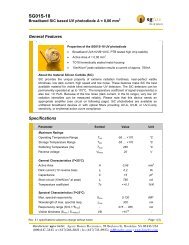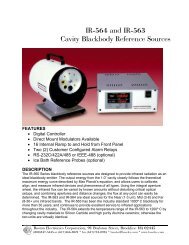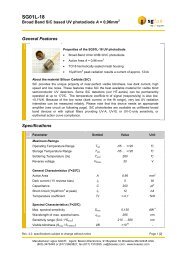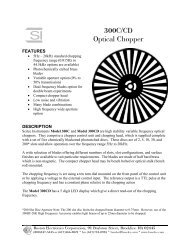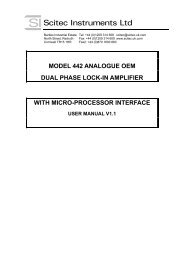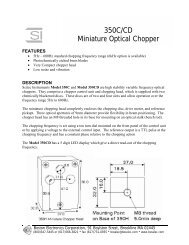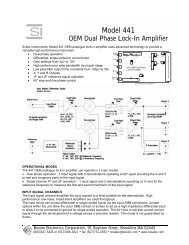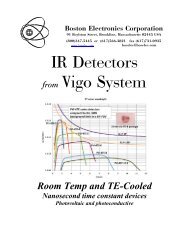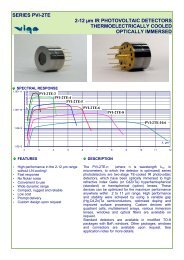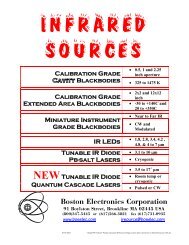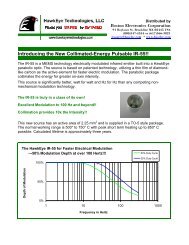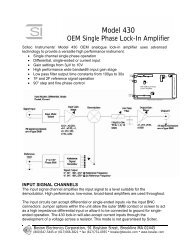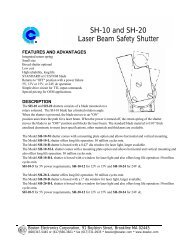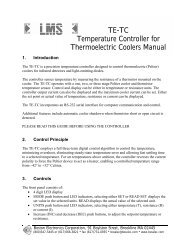TCSPC for FLIM and FRET in - Boston Electronics Corporation
TCSPC for FLIM and FRET in - Boston Electronics Corporation
TCSPC for FLIM and FRET in - Boston Electronics Corporation
Create successful ePaper yourself
Turn your PDF publications into a flip-book with our unique Google optimized e-Paper software.
A phase fluorometer of this type can be built up by us<strong>in</strong>g a commercially available network analyser<strong>and</strong> a laser diode. The setup is very simple - unless you have to build the network analyser. Thepr<strong>in</strong>ciple is shown <strong>in</strong> fig. 22. The network analyser runs afrequency sweep over a selectable frequency <strong>in</strong>terval. Theoutput signal of the network analyser drives a laser diodethat is used to excite the sample. The detected fluorescencesignal is fed back <strong>in</strong>to the signal analyser. The measurementdelivers the phase <strong>and</strong> the amplitude of the signal as afunction of the frequency. The network analyser is even ableto correct the results by us<strong>in</strong>g reference data recorded with ascatter<strong>in</strong>g solution <strong>in</strong> place of the sample.The mixers used <strong>in</strong> fig. 20 <strong>and</strong> 21 can be replaced with amodulated detector (fig. 23). A setup of this type has beenused <strong>for</strong> lifetime imag<strong>in</strong>g <strong>in</strong> a two-photon laser scann<strong>in</strong>gmicroscope [54]. A commercially available frequencysynthesiser generates the modulation frequency, theoscillator frequency <strong>and</strong> the difference of both with a highfrequency <strong>and</strong> phase stability. Mix<strong>in</strong>g is accomplished bymodulat<strong>in</strong>g the ga<strong>in</strong> <strong>in</strong> a photomultiplier. The mixed signalat the output of the PMT has a frequency of 25 kHz <strong>and</strong> isdirectly digitised. Further filter<strong>in</strong>g <strong>and</strong> phase calculation isdone digitally.The benefit of the detector modulation is that the modulationfrequency is not limited by the b<strong>and</strong>width of the ga<strong>in</strong> systemof the PMT. There<strong>for</strong>e relatively high modulationfrequencies can be used. The drawback is that the detector isa very poor mixer. This results <strong>in</strong> a poor efficiency of thedetector ga<strong>in</strong> modulation technique.If a Ti:Sa laser is used <strong>in</strong> a modulation system, e.g. <strong>for</strong> twophotonexcitation, the 80 MHz fundamental repetitionfrequency of the laser <strong>and</strong> its harmonics can be used asmodulation frequency. Due to the short pulse width theAmplifierspectrum of the laser modulation is actually a frequency comb that extends up to THz frequencies.By proper tun<strong>in</strong>g of the frequency synthesiser, any of the harmonics of the fundamental repetitionfrequency with<strong>in</strong> the detector b<strong>and</strong>width can be used <strong>for</strong> the phase measurement.A heterodyne system with a Ti:Sa laser, two-photon excitation <strong>and</strong> modulated PMT delivered alifetime accuracy of ± 300 ps <strong>for</strong> lifetimes between 2.4 <strong>and</strong> 4.2 ns [54]. This relatively pooraccuracy is probably due to the short acquisition time of only 160 µs per pixel or 10 seconds <strong>for</strong> a256 x 256 pixel image. Although the photon detection rate was estimated to be more than 10 8photons/s - which is probably an overestimation - the accuracy is of the same order as <strong>for</strong> <strong>TCSPC</strong>imag<strong>in</strong>g with 10 6 photons per second <strong>and</strong> the same acquisition time <strong>and</strong> pixel number.The efficiency of the s<strong>in</strong>gle channel modulation technique <strong>in</strong> terms of photon counts stronglydepends on the operat<strong>in</strong>g conditions. Results of Monte-Carlo simulations of the efficiency <strong>for</strong>s<strong>in</strong>gle-exponential decay are given <strong>in</strong> [39]. The simulations yield ‘F values’, i.e. the ratio of theideal SNR to the SNR achieved by the <strong>in</strong>vestigated method.For a setup with separate detector <strong>and</strong> mixer, s<strong>in</strong>e-wave-modulated excitation, s<strong>in</strong>e-wave mix<strong>in</strong>g<strong>and</strong> 100% modulation of the excitation F was found to be 3.7. If the modulation is less than 100% aLaserDiodeNetwork AnalyserRF outDiode BiasSampleRF <strong>in</strong>DetectorAmplifierFig. 22: Phase fluorometer with a networkanalyserFrequencySynthesiserLaser Modulator Samplef modf oscf mod - f oscdigitiserA/DGa<strong>in</strong>modulatedDetectorA/Ddigital filterphase calculationf mod - f oscdigitiserFig. 23: Mix<strong>in</strong>g by ga<strong>in</strong>-modulat<strong>in</strong>g the detector19



